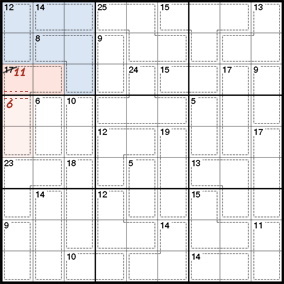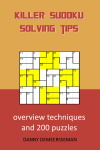PUZZLE TECHNIQUES
KILLER SUDOKU TIPS AND TRICKS
The Killer Sudoku is a very popular sudoku variant. If you have our tips, go to Killer Sudoku Online to complete our puzzles in increasing difficulty.
As you already know by now, use only logical steps to solve puzzles.
When solving a Killer Sudoku you have to follow all the rules of the regular sudoku.
In addition, a Killer Sudoku is divided into regions and the sum of the numbers in each region (called a cage) is indicated in the top left box of each region. Each digit in a region can only appear once. Also known as Sum-Sudoku or Samunamupure, this variant was created by combining elements of Sudoku and Kakuro.
SOME TERMINOLOGY FIRST
Before we start with our advanced strategies and solving techniques we give you an overview of the meaning of the terms we use in our explanation:
- cell: a box in the grid that fits one digit.
- row: a horizontal line of 9 cells.
- column: a vertical line of 9 cells.
- block: a collection of 3x3 cells surrounded by thicker boundary lines also called subgrid.
- house: a house is therefore a row, column or block.
- cage: a cage is a number of cells. The number in the top left of the cage is the sum of the numbers that belong to this cage. A cage may NOT contain equal numbers.
KILLER SUDOKU CHEAT SHEET WITH COMBINATIONS
Consult our list with met Killer Sudoku Combinations. It is useful to print this cheat sheet to help you solve a Killer Sudoku.
LIMITED POSSIBILITIES
The total of combinations of a number depends on the amount of cells. You are more likely to find the numbers of regions with limited options. First look for a cage with maximum 2 cells. You then have a maximum of 4 combinations.
For cages with 7 cells, the maximum number of digit combinations is also limited to 4. Cages with 8 or 9 cells have only 1 combination.
Sums with only 1 combination can be entered directly.
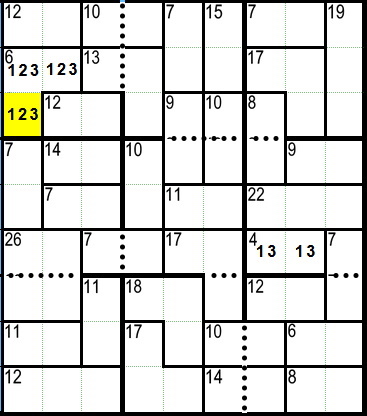
REQUIRED DIGIT
This is a great strategie. Sometimes you have a situation where a certain digit can only belong to a certain cage.
We clarify this with the example from above where in block 6 the numbers 1 and 3 are already in cage 4. In the list of number combinations, in addition to numbers 22 with 3 cells, we find the combinations 589 and 679. If we now look at numbers 8, we notice that this number can only be in cage 22, so we have to choose 589 and the rest of block 6 is then simple.
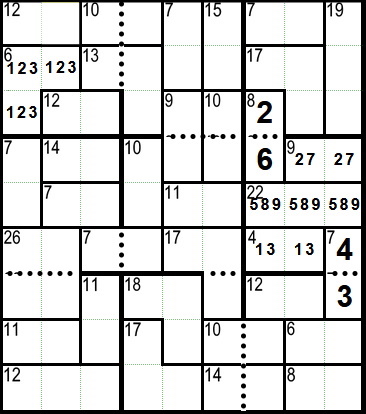
REDUCE NUMBER COMBINATIONS
A house (= row, column or block) with a cage of which we know the combination can help to limit the number of combinations in other cages.
In our example we find a cage with 2 cells and sum 7 in row 6. This gives 3 combinations: 16-25-37. However, we have already entered the combination 13 in cage 4. So for cage 7 only 25 remains as a combination.
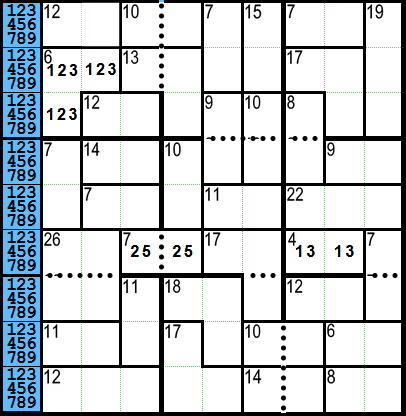
RULE 45 WITH INNIES AND OUTIES
The rule of 45 refers to the fact that 45 is the sum of numbers 1 through 9. So the sum of each house (= row, column or block) is equal to 45.
Now if we add up the sums of the cages in a house, they are also 45 provided that the cages fit completely into that house. However, this is rare. Usually we have the following:
- A cell outside the house = outie
- A cell within the house of a cage that is outside the house = innie
If we only have one outie or innie, then we can directly place the number in that cell. The number is then the difference between 45 and the sum of the cages in that house. An example for extra clarity!
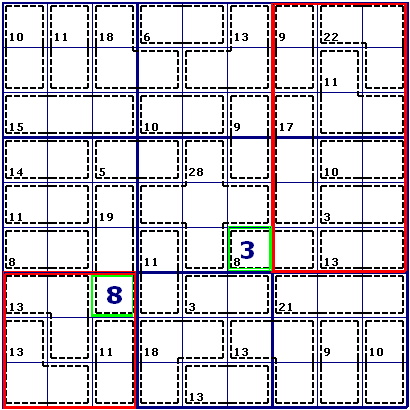
- Digit 8: we are looking at block 7 (= bottom left). The sum of the cages that completely fall into this block is 13 + 13 + 11 = 37. So you need 8 more to have 45.
- Digit 3 : we are now looking at block 3 (= top right) and block 6 (= center right). The sum of the cages that completely belong to both blocks is 9 + 22 + 11 + 17 + 10 + 3 + 13 = 85. Then we do 85 + 8 = 93. So you have 3 for the cell outside these 2 blocks.
EQUAL NUMBER OF CELLS INSIDE AND OUTSIDE
The above advanced solving technique involved one cell each time. Here we also rely on the rule of 45, but it concerns more than one cell. However, as many cells inside as outside. In the example below, look at block 1 with cage 17 of which 2 cells are inside and 2 cells are outside block 1. We can now only determine the sum of the part inside and the part outside the block.
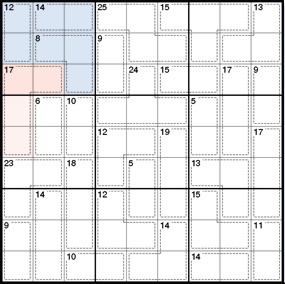
The total for block 1 is 12 + 14 + 8 = 34. This gives 11 (45-34 = 11) as a total for the portion of cage 17 that is in block 1 and 6 for the portion of cage 17 outside block 1 (17–11 = 6). Now you can split cage 17 into two cages of 2 cells each.
